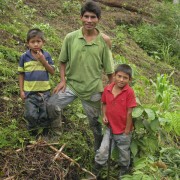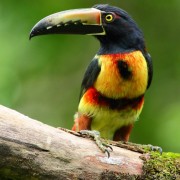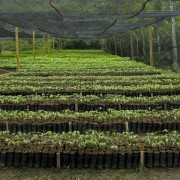Land For Life Project, Honduras
This is a 10-year program which supports over 200 families in the area surrounding Pico Bonito National Park, Northern Honduras, to give up the practice of slash and burn and switch to sustainable agriculture using Inga Alley Cropping, which has given them food security and cash crops.
We are doing this by working with each family to implement the flexible Guama Model for Inga Alley Cropping in the way which best meets the individual needs of each family. Alongside Inga Alley Cropping, there is support for families to establish fruit-tree crops and to reforest areas of their land. (Full details on the Guama Model and the strategy behind it can be found here.) Each new family has been asked to plant a small number of Inga trees as an orchard to provide enough seed for a further 3 families to take up alley cropping.
- Don Martin y sus callejones con Guama.
- Local Farmer Don Santiago with his developing Inga alleys
- Sustainable firewood produced by Inga alley cropping
- Don Maximino y familia en sus callejones de Guama recién sembrado.
- Distributing rainforest seedlings for reforestation
- Toda la familia unida en su esfuerzo a sembrar Guama y ganar seguridad alimentaria
- Reunion con campesinos interesdaos en el proyecto
Our work is focused on the communities living in two key river catchments which border Pico Bonito National Park – the Cuero and the Cangrejal River Valleys.
The Cuero and Cangrejal Valleys are of critical conservation importance as they border Pico Bonito National Park which holds a large area of primary tropical rainforest which is home to jaguars, pumas and howler monkeys alongside a wealth of other biodiversity. As well as this, the Park also provides important ecosystem services, including maintaining and regulating the flow of the area’s rivers and preventing soil erosion and landslides on the steep mountainous terrain. Slash and burn farming is a major threat to the Park, with much of the buffer zone already degraded by subsistence farming practices and the core zone increasingly at risk.
- El Bejuco Waterfall, Pico Bonito National Park
- Collared Aracari, Pico Bonito (Photo by James Adams)
- Jaguar in Pico Bonito (Photo: Pathera)
- Glasswing Butterfly, Pico Bontio
Las Flores Project Center
A key element of the Land for Life Project is the establishment of a Project Center. In 2012 we purchased a 17 acre piece of land in the Cuero Valley for our Project Center, which includes a demonstration farm to showcase the benefits of Inga Alley Cropping, an Inga seed orchard, a tree nursery, education facilities and a cash crop processing area.
Since 2012 we have made great progress in getting the Project Center up and running. The Inga seed orchard has been planted and produced our first crop of over 200,000 seeds in Sept 2014. A large tree nursery has been constructed and currently houses over 75,000 seedlings, including cacao, rambutan, mahogany, and of course Inga. The Inga alleys for the demonstration farm are growing pineapple, plantain, malanga ( taro), datil bananas and we are developing pepper.
- Cacao seedlings soaking up the morning sun in our tree nursery
- Inga Director, Mike Hands, and Field Director, Abraham, amongst the Inga alleys of our demonstration farm
- Thouands of seedlings in our new tree nursery
- Layout of our Project Center, with Inga Director Mike kindly standing in to give a sense of scale.
In the long term, the Project Center will serve as the nerve center as we work to spread Inga Alley Cropping across Central America. The Center will host courses, allowing groups from across Central America to come and see Inga Alley Cropping in action both on the Project Center and in the local area, then return and disseminate the knowledge of this revolutionary alternative to slash and burn within the communities where they work and live.
















